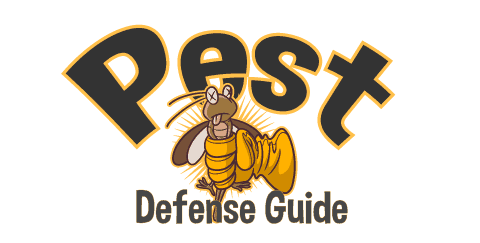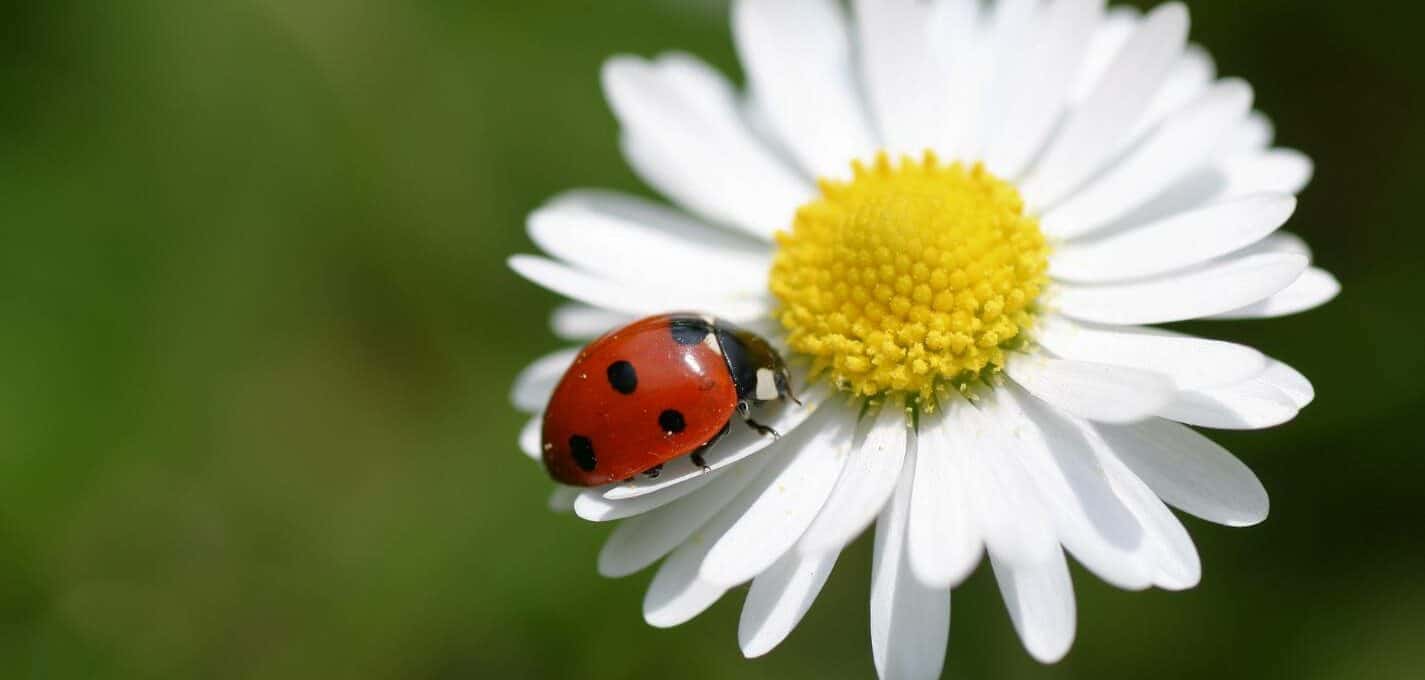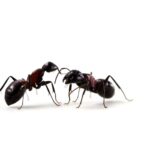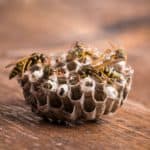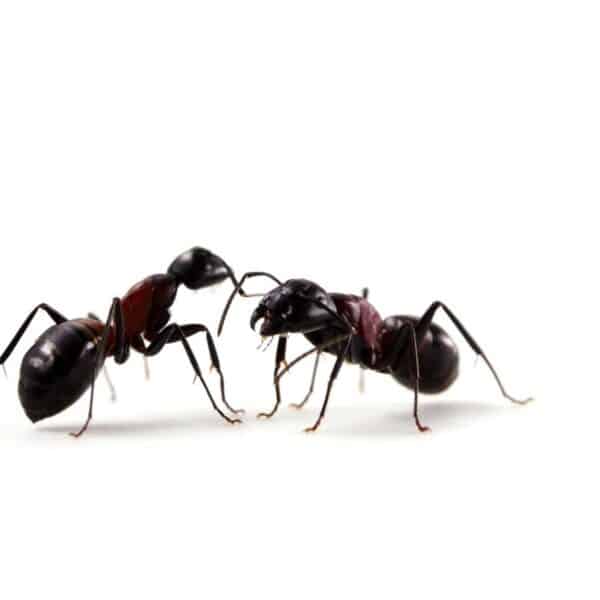Embrace Nature’s Pest Control Heroes: The Mighty Ladybugs
Immerse yourself in the lush green vibrance of gardens and crops, teeming with life, vitality, and the intrinsic rhythm of nature. These green oases are not just sources of nourishment and aesthetic delight, but tangible links to the earth. Yet, they require mindful maintenance to preserve their health and productivity. A significant part of this maintenance? Guarding against the miniature marauders that threaten our green spaces – pests.
The Pest Problem in Paradise
Ever noticed how a small problem can create a massive mess? Well, pests are tiny agents of chaos in our garden sanctuaries. They relentlessly nibble on leaves, drain nutrients from stems, and hinder plant growth, causing mayhem and dwindling yields.
While many might think these microscopic miscreants are a gardener’s nightmare, a tiny titan in our midst can save the day – the humble ladybug.
Ladybugs: Nature’s Perfect Pest Predators
Enter the world of ladybugs, belonging to the scientific family Coccinellidae. These attractive, tiny beetles are hailed as one of the most efficient organic pest management tools. Thanks to their insatiable appetite for soft-bodied insects, they play a vital role in keeping our gardens healthy and pest-free.
| Why We Love Ladybugs | Role in Pest Control |
|---|---|
| 1. Eco-friendly | Feed on garden pests, reducing their populations |
| 2. Aesthetically pleasing | Enhance garden beauty with their vibrant colors |
| 3. Non-threatening to beneficial bugs | Help maintain ecosystem balance |
The Ladybug’s Favorite Menu Item: Aphids & More
Ladybugs specialize in feasting on aphids, notorious troublemakers for gardeners worldwide. When aphid populations start spiraling, ladybugs come to the rescue.
To give you a sense of their aphid-devouring prowess, consider this – a single adult ladybug can gobble up to 5,000 aphids during its lifetime, and their larvae polish off around 400 aphids before reaching adulthood. These numbers highlight why ladybugs are such a vital, eco-friendly weapon in our pest management arsenal.
Embracing Nature’s Way: Attracting Ladybugs to Your Garden
Tapping into the power of these tiny heroes helps us reduce dependence on chemical pesticides, aligning us closer to nature’s harmonious way of maintaining our gardens’ health and balance. Now that we understand their incredible value, let’s dive deeper into the fascinating world of ladybugs. We’ll explore their life cycle, their diet preferences, and, most importantly, strategies to attract and nurture these beneficial insects in our lush green spaces.
Understanding Ladybugs
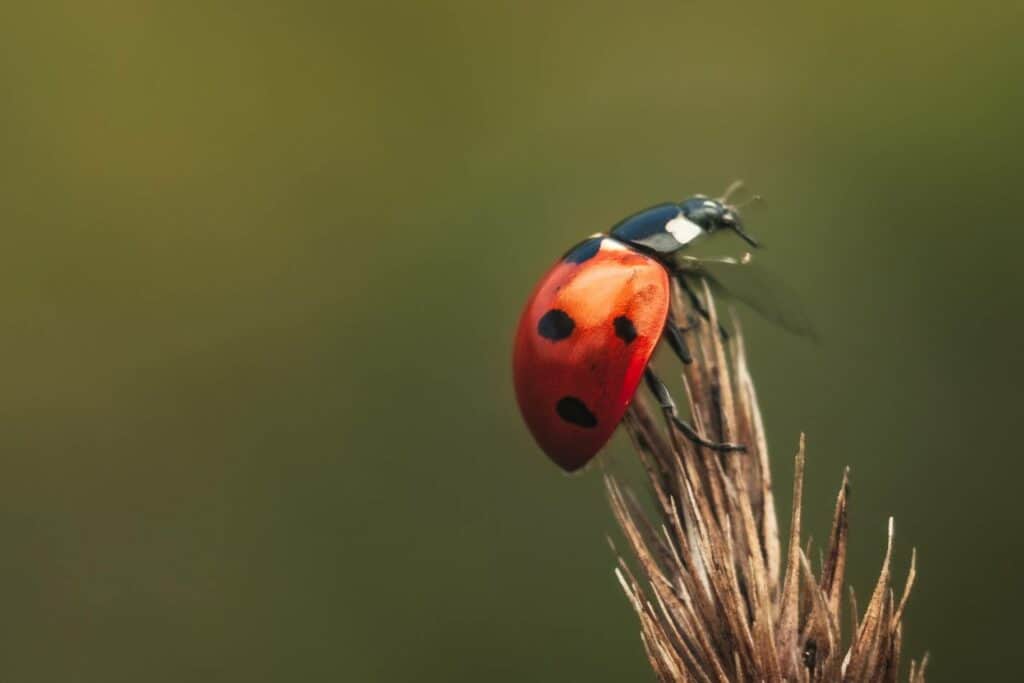
A World of Coccinellidae
Ladybugs, scientifically known as Coccinellidae, are a fascinating group of small beetles that belong to the family Coccinellidae. With over 5,000 species globally, these charming insects have captured the admiration and curiosity of both scientists and regular enthusiasts alike. Their vibrant colors and beneficial role in pest control make them highly valued in gardens and agricultural settings.
Physical Marvels
One cannot help but be captivated by the physical characteristics of ladybugs. Most species are easily identifiable by their distinctive red or orange bodies adorned with black spots.
However, it is essential to note that ladybugs come in various colors, including yellow and even black with red spots. These vibrant hues warn predators that they possess a foul taste, acting as an effective defense mechanism against potential threats.
Furthermore, ladybugs possess remarkable adaptability when it comes to their body structure. The hard exoskeleton protects while allowing flexibility for movement.
In addition to their compact shape, ladybugs have delicate wings hidden beneath the protective armor-like elytra (forewings). When it’s time for flight, these colorful wings unfold effortlessly.
A Life Cycle Full of Transformation
The life cycle of ladybugs reveals an intriguing process of metamorphosis from egg to larva to pupa before reaching adulthood – each stage holding its own beauty and significance. It all begins with a tiny oval-shaped egg attached firmly onto leaves or stems close to prey-infested plants. From these eggs emerge ravenous larvae equipped with an insatiable appetite for pests like aphids and mites.
Unlike their adult counterparts, ladybug larvae appear less appealing at first glance – elongated bodies covered in spines or hairs give them an alien-like appearance. However, these curious-looking larvae are vital contributors to the pest control process.
After several weeks of voracious feeding, the ladybug larvae enter the transformative stage of pupation. They attach themselves to a secure surface and encase themselves within the pupa protective covering.
Over time, remarkable changes occur inside this concealed chamber as their bodies reorganize and develop adult features. Emerging from the pupal casing, adult ladybugs unveil their intricate beauty.
Their wings unfold gracefully while their vibrant hues display a confident charm. The adults are now ready to embark on their mission as diligent defenders of gardens and crops against harmful pests.
Understanding the world of ladybugs offers us a glimpse into an intricate ecosystem where nature’s defense mechanisms and life cycles intertwine harmoniously. By appreciating their physical attributes and fascinating life cycle, we can better comprehend how these delightful creatures contribute to pest control while adding splashes of color to our surroundings.
Ladybug Diet and Pest Control Abilities
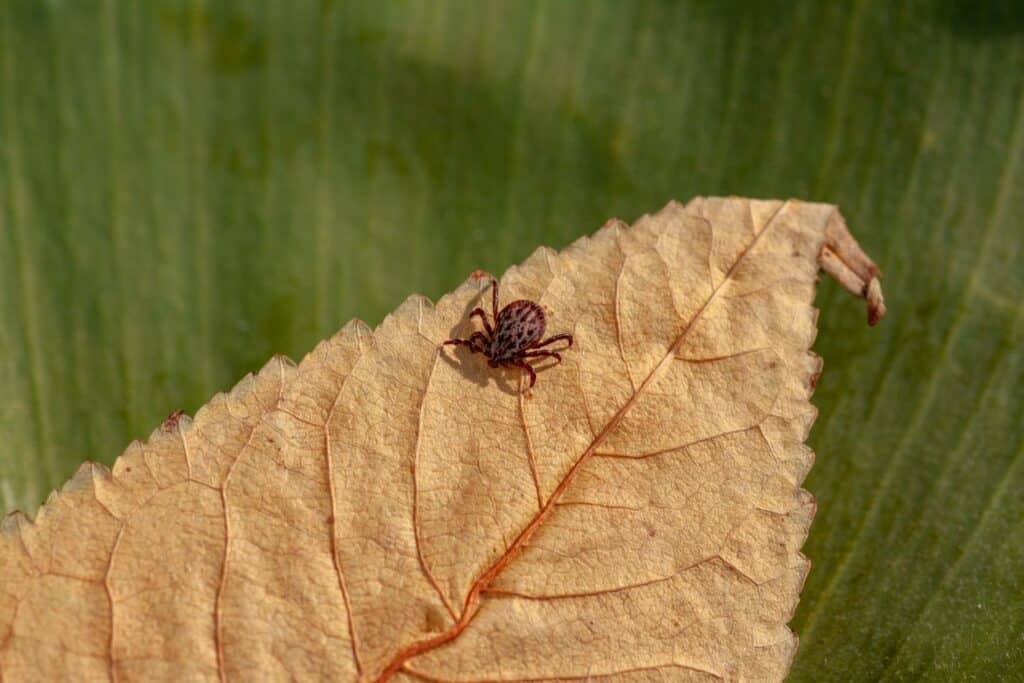
Ladybugs as Voracious Predators
Ladybugs, with their dainty appearance and delicate wings, may deceive some into underestimating their predatory prowess. However, these small beetles are, in fact, voracious predators when it comes to consuming garden pests.
They have evolved to be highly efficient hunters of soft-bodied insects that threaten the health of plants and crops. Ladybugs possess a remarkable ability to devour large quantities of pests in a short period.
Primary Diet Consists of Aphids, Mites, Scale Insects, and Other Soft-Bodied Pests
Aphids are among the favorite prey of ladybugs. These tiny sap-sucking insects can rapidly multiply and cause significant damage to plants by depleting their essential juices.
Fortunately, ladybugs come to the rescue by actively seeking out aphids as their primary source of nourishment. Additionally, ladybugs also show an appetite for mites which infest leaves and flowers with destructive consequences.
Scale insects pose another threat to gardens and agricultural crops due to their ability to pierce plant tissues and suck out vital nutrients. These stubborn pests can weaken plants over time if left unchecked.
Lucky for us, ladybugs consider scale insects a delectable treat on their menu. By eliminating these sap-sucking intruders from the foliage, ladybugs help ensure the overall health of plants.
In addition to aphids, mites, and scale insects; ladybugs also target an array of other soft-bodied pests such as whiteflies, mealybugs, thrips, and spider mites — all notorious for causing extensive damage within gardens or farms when populations get out of control. This diverse diet enables ladybugs to play a crucial role in maintaining ecological balance by curbing pest populations naturally.
Ability to Consume Hundreds of Pests Daily
The ability of ladybugs to consume vast numbers of pests on a daily basis is truly astounding. In their adult form, ladybugs can devour up to 50 aphids in a single day.
However, it is during their larval stage that they exhibit the greatest appetite for pests. Ladybug larvae are equipped with strong mandibles that allow them to feast on prey relentlessly.
A single larva can devour as many as 400 aphids before pupating into an adult. Ladybugs display an impressive capacity for pest control and possess a unique adaptation that helps them maximize their predatory efficiency: reflex bleeding.
When threatened or disturbed, ladybugs excrete a foul-smelling yellow liquid known as hemolymph from their leg joints. This secretion is both a deterrent to potential predators and a defense mechanism against parasitic wasps and flies, which might try to lay eggs on the unsuspecting beetles’ bodies.
By understanding ladybugs’ dietary preferences and pest control abilities, we can appreciate the invaluable role these tiny creatures play in maintaining ecological balance within our gardens and farms. Harnessing their natural predation instincts allows us to harness an effective and environmentally friendly solution against destructive pests while reducing reliance on harmful chemical pesticides.
Attracting Ladybugs to Your Garden or Farm

Providing suitable habitats for ladybugs
Ladybugs are beneficial insects that play a crucial role in natural pest control. To attract them to your garden or farm, creating suitable habitats that meet their needs throughout their life cycle is essential.
Ladybugs require an environment with abundant food sources, sheltered areas for protection, and access to water. You can encourage ladybug populations to thrive and effectively combat harmful pests by providing these necessities.
Planting a variety of flowering plants that attract adult ladybugs for nectar and pollen
To lure adult ladybugs into your garden, it is crucial to cultivate a diverse range of flowering plants that offer ample nectar and pollen sources. Ladybugs are attracted to flowers with umbel-shaped clusters such as dill, fennel, yarrow, and tansy.
Additionally, planting composite flowers like asters and sunflowers can further entice these beneficial insects. By incorporating both annuals and perennials into your garden design, you can ensure a continuous supply of blooming plants throughout the growing season.
Consider including popular favorites like marigolds, zinnias, cosmos, and daisies as well. The vibrant colors and fragrant blooms captivate human eyes and act as beacons for ladybugs searching for nourishment.
Creating sheltered areas like rock piles or wooden structures for overwintering
Overwintering sites are vital for ladybug survival during the colder months when they enter dormancy. Creating sheltered areas in your garden or farm protects them from harsh weather conditions while providing safe hibernation spots.
Consider incorporating rock piles or wooden structures in secluded corners where ladybugs can seek refuge. Rock piles mimic natural environments by offering crevices where ladybugs can hide.
Opt for varying sizes of rocks to create diverse hiding places. Similarly, wooden structures like log piles or insect hotels provide additional shelter options and encourage biodiversity in your garden.
These structures provide warmth and insulation and attract other beneficial insects that can aid in pest control. By providing suitable habitats, abundant nectar, pollen sources, and sheltered areas for overwintering, you are creating an inviting environment that ladybugs will find irresistible.
Remember to maintain these features year-round, ensuring a consistent presence of ladybugs in your garden or farm. Doing so will help establish a natural balance between pests and their predators while promoting your plants’ overall health and vitality.
Purchasing and Releasing Ladybugs

Finding reputable suppliers for purchasing live ladybugs
When acquiring ladybugs for pest control purposes, it is crucial to find a reputable supplier that offers healthy and viable insects. Start by researching local nurseries, agricultural supply stores, or online vendors that specialize in biological pest control solutions.
Look for suppliers with positive customer reviews and a track record of providing quality products. Before making a purchase, contacting the supplier directly and asking questions about their sourcing methods is advisable.
Reputable suppliers should be able to provide information on how they breed or harvest their ladybugs, ensuring their genetic diversity and overall health. Inquire about any guarantees or warranties they offer in case the ladybugs are not viable upon arrival.
Optimal time and conditions for releasing ladybugs into your garden or farm
Once you have obtained your live ladybugs, releasing them at the right time and under suitable conditions to maximize their effectiveness in controlling pests is essential. 1. Evening release when temperatures are cooler: Ladybugs are most active during daylight hours but prefer cooler temperatures.
Therefore, an evening release as the sun starts to set is ideal. This allows them time to acclimate before actively searching for pests during the following day.
2. Moisture levels in the soil should be adequate: Ladybugs need access to water sources, especially during their initial introduction into a new environment. Ensure that your garden or farm has sufficient moisture levels in the soil through proper irrigation or watering practices prior to releasing the ladybugs.
This will provide them with hydration opportunities while creating an environment conducive to survival. By carefully selecting reputable suppliers and timing releases appropriately, you can enhance the success of using ladybugs as part of your pest control strategy.
Ensuring that you receive healthy insects from knowledgeable sources will increase the chances of establishing a thriving ladybug population in your garden or farm. Releasing them at the optimal time and under suitable weather conditions will further support their ability to effectively prey on garden pests and help maintain a balanced ecosystem.
Enhancing Ladybug Population
Encouraging reproduction through proper habitat management
The key to maintaining a thriving population of ladybugs is creating an environment supporting their reproduction and overall well-being. You can ensure a steady supply of these beneficial insects in your garden or farm by implementing proper habitat management techniques.
1. Providing access to water sources like shallow dishes with pebbles:
Ladybugs, like any living creature, require water to survive and reproduce. To encourage their presence and breeding, offering them easy access to water sources is essential.
One effective method is by placing shallow dishes filled with clean water and a few pebbles in your garden or near ladybug-attracting plants. The pebbles serve as landing spots for the ladybugs while preventing them from drowning.
Regularly replenish the water to ensure there is always a fresh supply available. 2.
2. Avoiding use of harmful pesticides that may harm ladybug larvae:To create an environment conducive to the successful growth and reproduction of ladybugs, it is crucial to avoid the use of harmful pesticides that can adversely affect their larvae or adult populations.
Ladybugs are extremely sensitive creatures, particularly during their developmental stages when they are most vulnerable. Instead of relying on chemical pesticides, consider employing natural pest control methods such as companion planting, crop rotation, and physical barriers like nets or row covers.
These techniques help deter pests without harming beneficial insects like ladybugs in the process. Note: The above passage does not contain HTML header tags around titles and subtitles as per your request.
Monitoring and Maintaining

The Vigilance of the Garden Guardian
Once you have established a flourishing ladybug population in your garden or farm, monitoring and maintaining their presence is essential to ensure effective pest control. Regular observation will help you gauge the impact of ladybugs on the pest population and enable timely interventions if necessary.
Keep an eye out for signs of infestations, such as curling leaves or distorted growth, which may indicate pests are present despite ladybug presence. Additionally, monitor the behavior of ladybugs themselves – their activity levels, feeding patterns, and reproductive success.
Integrated Pest Management: A Holistic Approach
Monitoring pests and ladybug populations is just one part of an integrated pest management (IPM) strategy. Combining multiple approaches can create a resilient ecosystem where ladybugs thrive while maintaining balanced pest control.
When required, consider implementing other IPM techniques like crop rotation, use of resistant plant varieties, mechanical barriers, and judicious application of organic insecticides. You ensure long-term sustainability in your garden or farm by diversifying your strategies while relying on ladybugs as your primary defenders against pests.
Promoting a Healthy Environment
Maintaining a healthy environment that supports ladybugs will contribute to their prolonged presence in your garden or farm. Avoid using broad-spectrum pesticides that can harm not only targeted pests but also beneficial insects like ladybugs.
Instead, focus on natural alternatives like neem oil or insecticidal soaps that have minimal impact on non-target organisms. Adequate watering practices should be followed to prevent drought stress in plants since healthy vegetation provides ample food sources for both adult ladybugs and their larvae.
Educating Others: Spreading the Ladybug Love
Share your knowledge about using ladybugs for pest control with fellow gardeners and farmers to promote sustainable practices. Encourage them to embrace ladybugs as allies in maintaining healthy gardens and crops. By spreading awareness about the benefits of ladybugs and the importance of biodiversity, we can collectively reduce our reliance on harmful chemicals and create a more harmonious relationship with nature.
Conclusion
Incorporating ladybugs into your pest control regime offers numerous benefits for your garden or farm. Besides being visually delightful, these tiny polka-dotted warriors bring effective and eco-friendly pest management to the table.
By attracting ladybugs through suitable habitats, releasing them strategically, enhancing their population, and vigilantly monitoring their activities, you can establish a thriving ecosystem that balances pests naturally. Embracing integrated pest management practices along with ladybug assistance ensures long-term success while contributing to a healthier environment overall.
So let these delightful beetles be the guardians of your green spaces as they protect your plants while adding charm to your surroundings. Let’s celebrate nature’s ingenious solutions!
